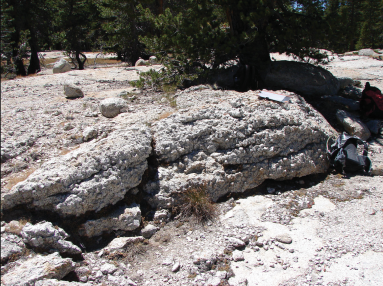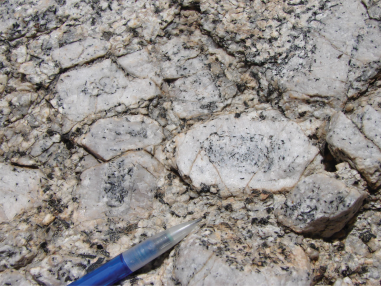The background image is of peaks within the cathedral range outside Yosemite.

K-feldspar megacryst of the Cathedral Peak granodiorite that has been selected for our analysis.
Research Objectives
To understand and analyze trace element composition of potassium feldspar using analysis transect from core to rim by laser ablation. An analysis transect would be important because it can measure abundance and is used for observations. In order for our project to be executed, the parameters of the LA-ICP-MS such as spot size, energy percentage, and shot count would all have to be evaluated.
It is hypothesized that the potassium feldspar crystals grew fast during the final stages of pluton crystallization, fluid Infiltration causes the grains to increase in size, fewer big crystals grow rather than many of the small crystals, and the potassium feldspar crystals moved from one magma to another and continue the growth process.
Researchers are interested in the potassium feldspar found in Yosemite National Park’s Tuolumne Intrusive Suite due to its significance in unraveling the geological history and processes that shaped the region. The study of potassium feldspar in this granitic intrusion provides insights into the suite’s petrology, mineralogy, and the conditions under which the rocks formed. The potassium feldspar in the Tuolumne Intrusive Suite offers clues about the tectonic history of the Sierra Nevada region and its connection to the suite’s formation. Scientists can use dating techniques with potassium feldspar to determine the age of rocks in the Tuolumne Suite, refining the timeline of geological events in Yosemite National Park. Understanding the distribution of different rock types and mineral assemblages, including potassium feldspar, within the Tuolumne Suite is essential for geological mapping and comprehending the park’s geological history. The unique geological features of Yosemite National Park, including the Tuolumne Intrusive Suite, attract geological researchers and students, contributing to the broader understanding of Earth’s geological past.
Analyzing the elemental composition of potassium feldspar megacrysts from the Tuolumne Suite in Yosemite National Park can offer valuable insights into the geological history of the suite, revealing details about their source and formation processes. The chemical composition of these megacrysts provides a means to understand the magmatic processes that transported them to the Earth’s surface, providing information about the temperature, pressure, and chemical conditions during their formation and the history of magmatism in the region. Elemental data from these megacrysts can contribute to understanding the tectonic context in which the Tuolumne Suite formed, potentially indicating the involvement of specific tectonic processes, such as subduction or intraplate events. The elemental composition helps identify and classify the minerals within the megacrysts, offering insights into the mineral assemblage and the types of minerals present in the Tuolumne Suite. The elemental composition of the megacrysts provides insights into the geochemical evolution of the Yosemite region over time, helping to trace changes in magmatic processes and geological events. These megacrysts can provide clues about the characteristics of the mantle from which they originated, with specific elements or isotopic ratios indicating the nature of the mantle source. The elemental data can be used in geological mapping to understand the spatial distribution of different rock types and mineral assemblages within the Tuolumne Suite, contributing to geological cartography in the area.


On left: outcropping K-feldspar megacrysts in the Cathedral Peak granodiorite.
On right: up close view of K-feldspar megacrysts within Cathedral Peak transition zone